Pirates, Privateers & Corsairs
Did the Barbary Pirates visit Devon?
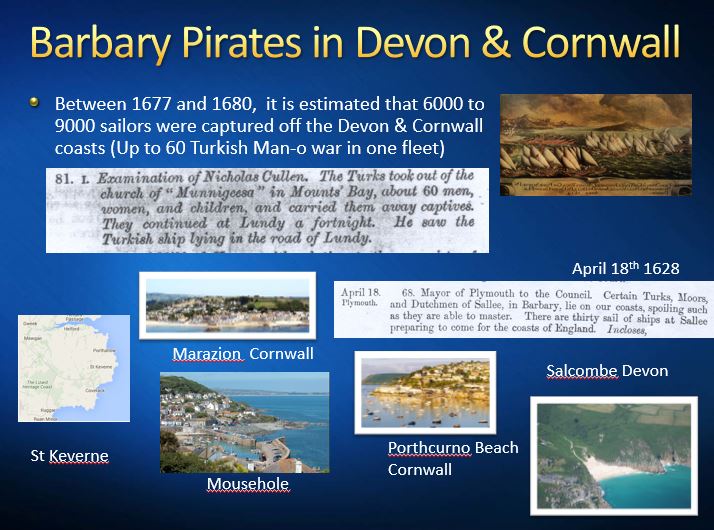
There is quite a lot of evidence that the Barbary Pirates did visit Devon & Cornwall. We also know that some of the local pirates including the Nutt brothers from Lympstone joined them in some of there raids.
Barbary Pirates raid Iceland
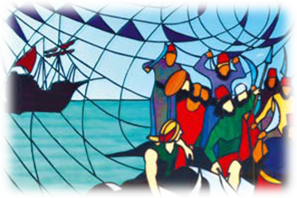
The Turkish Abductions (Icelandic: Tyrkjaránið) were a series of slave raids by Ottoman pirates that took place in Iceland between June 20 – July 19, 1627. Pirates from Morocco and Algeria, under the command of Dutch pirate Murat Reis, raided the village of Grindavík on the southwestern coast, Berufjörður and Breiðdalur in the Eastern Region (the East Fjords), and Vestmannaeyjar (islands off the south coast); they captured an estimated 400–800 prisoners to sell into slavery.
Barbary Pirates raid Ireland
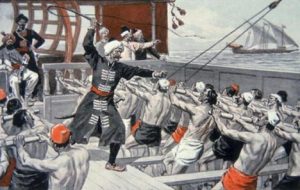
Having sailed for two months and with little to show for the voyage, Janszoon turned to a captive taken on the voyage, a Roman Catholic named John Hackett, for information on where a profitable raid could be made. The Protestant residents of Baltimore, a small town in West Cork, Ireland, were resented by the Roman Catholic native Irish because they were settled on lands confiscated from the O’Driscoll clan. Hackett directed Janszoon to this town and away from his own. Janszoon sacked Baltimore on June 20, 1631, seizing little property but taking 108 captives, whom he sold as slaves in North Africa. Janszoon was said to have released the Irish, and taken only English captives. Shortly after the sack, Hackett was arrested and hanged for his crime. “Here was not a single Christian who was not weeping and who was not full of sadness at the sight of so many honest maidens and so many good women abandoned to the brutality of these barbarians”.Only two of the villagers ever returned to their homeland.
Murat Reis the Younger (c. 1570 – c. 1641)
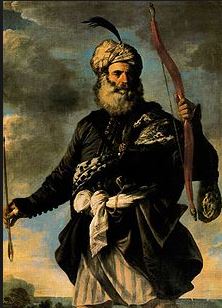
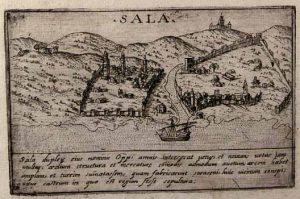 Jan Janszoon van Haarlem,commonly known as Murat Reis the Younger (c. 1570 – c. 1641), was a Dutch pirate who “turned Turk” after being captured by a Moorish state in 1618. He began serving as a Barbary pirate, one of the most famous of the 17th-century “Salé Rovers”. Together with other corsairs, he helped establish the independent Republic of Salé at the city of that name, serving as the first President and Grand Admiral. He also served as Governor of Oualidia
Jan Janszoon van Haarlem,commonly known as Murat Reis the Younger (c. 1570 – c. 1641), was a Dutch pirate who “turned Turk” after being captured by a Moorish state in 1618. He began serving as a Barbary pirate, one of the most famous of the 17th-century “Salé Rovers”. Together with other corsairs, he helped establish the independent Republic of Salé at the city of that name, serving as the first President and Grand Admiral. He also served as Governor of Oualidia
Why not look at the history and biographies of the well known Pirates, Privateers & Corsairs
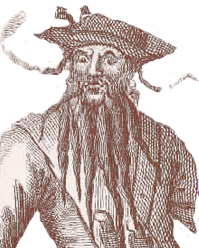
Piracy is an act of robbery or criminal violence by ship or boat-borne attackers upon another ship or a coastal area, typically with the goal of stealing cargo and other valuable items or properties. Those who engage in acts of piracy are called pirates. The earliest documented instances of piracy were in the 14th century BC, when the Sea Peoples, a group of ocean raiders, attacked the ships of the Aegean and Mediterranean civilizations. Narrow channels which funnel shipping into predictable routes have long created opportunities for piracy,as well as for privateering and commerce raiding. Historic examples include the waters of Gibraltar, the Strait of Malacca, Madagascar, the Gulf of Aden, and the English Channel, whose geographic structures facilitated pirate attacks.
The story of women on board Royal Navy Ships at the time of Trafalgar
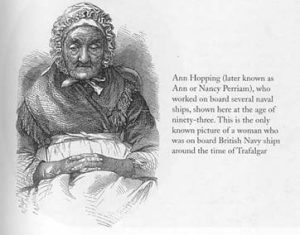
The Naval ships in the 17th & 18th centuries had many more women on board than people realise. Often, they were disguised as men and the Naval records record them as men. In particular there were many “Powder monkey’s” who were young girls dressed as women. There were few opportunities for work on shore and the navy was one of the biggest employers. The picture above shows Ann Hopkins who was one of the few women who were recorded and paid as women serving in the Navy.
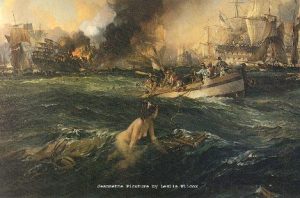 There were women on board RN ships before and during the battle of Trafalgar. They ranged from the wives of Captains and Officers. One or two Captains were reprimanded for taking women on board but many were not.
There were women on board RN ships before and during the battle of Trafalgar. They ranged from the wives of Captains and Officers. One or two Captains were reprimanded for taking women on board but many were not.
Jennette was recovered from the sea during the battle of Trafalgar. She had been on the French ship “Achilles”, seen on fire in the background.
Some of the roles of Women on board
Wives on board of :
Officers, Carpenters, Master Gunners, Boatswains
Passengers (Government Officials), Powder Monkeys, Daughters/sons of the families on board, Women crew disguised as men
Women Pirates, Prostitutes
Women helping the wounded and surgeon, Washing / sewing
Salcombe gold (Found by South West Maritime Archaeological Group)
Salcome Cannon Site
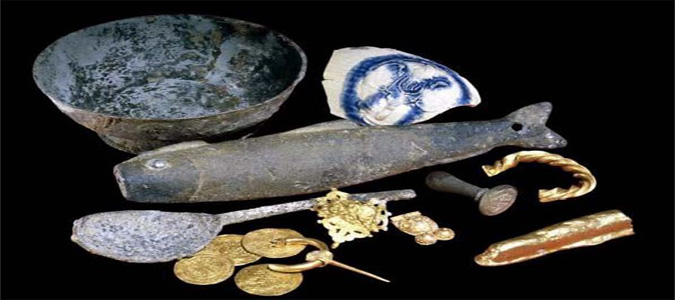
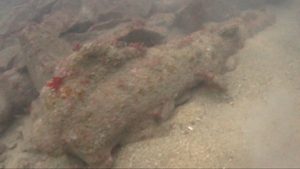 The Salcombe Cannon wreck site is close to two other designated wreck sites in the Erme Estuary which the South West Maritime Archaeological Group (SWMAG) are investigating. In 1992 this group described the Salcombe Cannon site as: “A cannon site with nothing else visible” but in 1994, following seabed changes, other artefacts including gold were revealed and the SWMAG began recording the site. Gold jewellery and coins dating between 1510 and 1636 have been recovered from the site and were purchased by the British Museum in 1998. For two seasons information about the site was initially kept confidential between the Receiver of Wreck, the finders and the Archaeological Diving Unit (working for the Advisory Committee on Historic Wreck). The site was designated under the Protection of Wrecks Act in 1997 when news about it was made public. The vessel is unknown but is dated between 1630 and 1640, and it has yielded the largest ever find of Moroccan gold in Europe .
The Salcombe Cannon wreck site is close to two other designated wreck sites in the Erme Estuary which the South West Maritime Archaeological Group (SWMAG) are investigating. In 1992 this group described the Salcombe Cannon site as: “A cannon site with nothing else visible” but in 1994, following seabed changes, other artefacts including gold were revealed and the SWMAG began recording the site. Gold jewellery and coins dating between 1510 and 1636 have been recovered from the site and were purchased by the British Museum in 1998. For two seasons information about the site was initially kept confidential between the Receiver of Wreck, the finders and the Archaeological Diving Unit (working for the Advisory Committee on Historic Wreck). The site was designated under the Protection of Wrecks Act in 1997 when news about it was made public. The vessel is unknown but is dated between 1630 and 1640, and it has yielded the largest ever find of Moroccan gold in Europe .
Moorsans Bronze age site
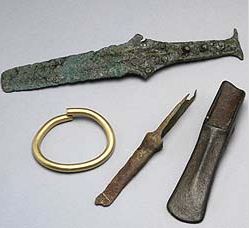
MoorSands site is from the middle Bronze Age (12th century BC)and is located off Prawle Point, south coast of Devon. it is in position 50 12 42N 03 44 20W and there is a 300m exclusion zone. The current licensee for the site is Neville Oldham. The site is of significant archaeological importance and consists of scattered middle Bronze Age implements about 1300 BC and suggests it was a vessel’s cargo which would make MoorSand one of the oldest shipwrecks discovered in Britain to date.
There is no evidence of any ship remains but the site indicates there was trade between Europe and the UK at the time. The adjacent image shows some of the artefacts that are in the British Museum (Photo British Museum)
Erme Estuary finds
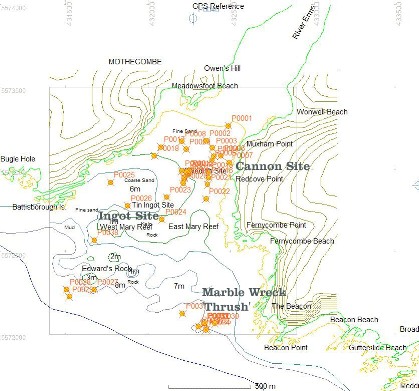
IThe River Erme is a small river which flows from the edge of Dartmoor to the south coast of Devon. Near its mouth, sandy beaches are
exposed on either side at low water. Seaward of the beaches, the estuary is flanked by commanding cliffs, while across the entrance is a
notorious reef called Mary’s Rocks. These rocks give the appearance of being split in two but consist of one reef with very narrow entrance channels on either side. They are only partially exposed at low water, while at high
water they can be covered by as much as 2 m. Immediately adjacent to the river mouth is the village of Mothecombe, but the dominant local
manor is Ermington, which has records dating back to the inquisition made during the reign of Edward I. Between the reef and beach there is 7-10 m of water, depending on the state of the tide. This can give the impression from the sea,
particularly at high water, that it is a tranquil and hospitable bay providing safe anchorage. However, it is far from being a place of refuge and local knowledge and extreme caution are required to navigate a boat safely to the
deep water behind the reef, even during calm conditions.
To sail no more
| ||

 On one dive during late summer in 2003 a diver searching the outer edges of the 17th century site came across the brick one side just visible above the sea bed, as these bricks contained metallic elements that gave a signal on the metal detector the diver pulled it out to pl ace it to one side, as he did so he noticed a defined shape under the brick, pulling that out also revealed a heavy lump of bronze which turned out to be a Bronze Age palstave axe head. Two Divers had come across these bricks over the years, why there were there so many scattered everywhere, lying alongside artefacts from the 17th Century and Bronze Age, they were soon to find out. In 2006 two of the team surveying the outer edges of the Protected area found a trail of bricks, they followed them and came across a huge pile of them, swimming over the top of the mound they discovered an anchor and chain, following the chain they discovered a winch, under the winch was a piece of pottery with the broken word ‘mouth’ impressed in the glaze. They had found the ‘Brick Wreck’ as it was soon to become known.
On one dive during late summer in 2003 a diver searching the outer edges of the 17th century site came across the brick one side just visible above the sea bed, as these bricks contained metallic elements that gave a signal on the metal detector the diver pulled it out to pl ace it to one side, as he did so he noticed a defined shape under the brick, pulling that out also revealed a heavy lump of bronze which turned out to be a Bronze Age palstave axe head. Two Divers had come across these bricks over the years, why there were there so many scattered everywhere, lying alongside artefacts from the 17th Century and Bronze Age, they were soon to find out. In 2006 two of the team surveying the outer edges of the Protected area found a trail of bricks, they followed them and came across a huge pile of them, swimming over the top of the mound they discovered an anchor and chain, following the chain they discovered a winch, under the winch was a piece of pottery with the broken word ‘mouth’ impressed in the glaze. They had found the ‘Brick Wreck’ as it was soon to become known. 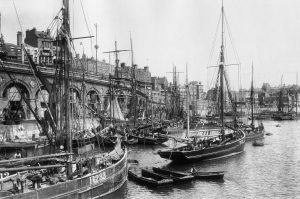
 By the time the newly built Lord Napier had joined the Ramsgate fishing fleet in 1868 the North Sea fishing industry was in full swing with the then small ports of Grimsby, Hull, Lowestoft and Ramsgate reaping the rewards of the rich North Sea fishing grounds. The fishing fleets of the West Country seasonally migrated to these East Coast ports chasing the fish and unloading 4 them at docksides with close access to the markets of London and the Midlands. In 1860 the first fish and chip shop opened in London and in just a few years the demand for fish grew and the North Sea provided an abundant supply of turbot, sole, hake, cod and plaice. Also at the time of the Lord Napier the east coast ports expanded with the influx of these fleets prompting the development of new houses around the docks which are still there to this day. Having such a large fleet operating from Ramsgate created a particular social problem in as much as the presence of young boys that crewed these fishing smacks, once ashore they had no fixed abode.
By the time the newly built Lord Napier had joined the Ramsgate fishing fleet in 1868 the North Sea fishing industry was in full swing with the then small ports of Grimsby, Hull, Lowestoft and Ramsgate reaping the rewards of the rich North Sea fishing grounds. The fishing fleets of the West Country seasonally migrated to these East Coast ports chasing the fish and unloading 4 them at docksides with close access to the markets of London and the Midlands. In 1860 the first fish and chip shop opened in London and in just a few years the demand for fish grew and the North Sea provided an abundant supply of turbot, sole, hake, cod and plaice. Also at the time of the Lord Napier the east coast ports expanded with the influx of these fleets prompting the development of new houses around the docks which are still there to this day. Having such a large fleet operating from Ramsgate created a particular social problem in as much as the presence of young boys that crewed these fishing smacks, once ashore they had no fixed abode.
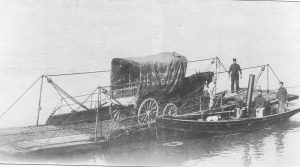 By 1878 there were over 200 Smack boys as they were known, many of them recruited from Reformatories, Poor Law Schools, Orphanages, and Training ships having no known parents. Local inhabitants were often disturbed by rowdy, cheeky boys in the streets until a local vicar took it upon himself to open a home especially for boys from these fishing smacks. Opened in 1881 as ’The Home for Smack Boys’ it lasted until the decline of the fishing fleet and the start of the First World War, it finally closed its doors in 1915 and is now the Harbour Office for Ramsgate. By 1898 the old fishing smacks were being replaced by the new steam trawlers, the Lord Napier now 30 years old was sold on to a William Hall of Galmpton, South Devon for the coastal trade, the articulated lorries of that time. She was not listed by Lloyds, in other words not insured for valuable goods cargo that is why we see her trading i n timber, sand, concrete, stone, slate, bricks and other heavy materials. A local Dartmouth newspaper writes in 1903 of “The Ketch Lord Napier hitting the Horse Ferry, resulting in spearing a covered wagon with her 5 bowsprit”. After taking two hours to disentangle her she proceeded up the River Dart narrowly missing the Floating Bridge (Ferry) only to run aground off Noss where she remained for several days. The skipper was either having a bad day or he was intoxicated, history does not record his eventual fate. The painting below is by ‘Robert Dennis’
By 1878 there were over 200 Smack boys as they were known, many of them recruited from Reformatories, Poor Law Schools, Orphanages, and Training ships having no known parents. Local inhabitants were often disturbed by rowdy, cheeky boys in the streets until a local vicar took it upon himself to open a home especially for boys from these fishing smacks. Opened in 1881 as ’The Home for Smack Boys’ it lasted until the decline of the fishing fleet and the start of the First World War, it finally closed its doors in 1915 and is now the Harbour Office for Ramsgate. By 1898 the old fishing smacks were being replaced by the new steam trawlers, the Lord Napier now 30 years old was sold on to a William Hall of Galmpton, South Devon for the coastal trade, the articulated lorries of that time. She was not listed by Lloyds, in other words not insured for valuable goods cargo that is why we see her trading i n timber, sand, concrete, stone, slate, bricks and other heavy materials. A local Dartmouth newspaper writes in 1903 of “The Ketch Lord Napier hitting the Horse Ferry, resulting in spearing a covered wagon with her 5 bowsprit”. After taking two hours to disentangle her she proceeded up the River Dart narrowly missing the Floating Bridge (Ferry) only to run aground off Noss where she remained for several days. The skipper was either having a bad day or he was intoxicated, history does not record his eventual fate. The painting below is by ‘Robert Dennis’
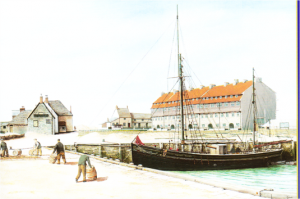 By 1904 it was obvious she was nearing the end of her days, research shows that her owner William Hall had connections with Topsham near Exeter and so he sold her on the Trout’s, a well known Topsham shipping family at the time, who had a reputation of buying up old vessels cheaply and fitting them out to do heavy dirty work. Her rig was changed from Ketch to a Yawl and she plied the south coast with all manner of heavy goods. Bridport Harbour records several such cargo’s being loaded on the Lord Napier to Dartmouth and Exmouth. And it so it was on her final voyage with a cargo of bricks, she ended her 43 year career as she slipped beneath the calm waters off Salcombe that April day in 1911. So that was the end of the Lord Napier, but what of her crew and owners? Research continued, revealing a fascinating story of the end of 19th Century and the beginning of the 20th, reopening individual lives in those troubled times.
By 1904 it was obvious she was nearing the end of her days, research shows that her owner William Hall had connections with Topsham near Exeter and so he sold her on the Trout’s, a well known Topsham shipping family at the time, who had a reputation of buying up old vessels cheaply and fitting them out to do heavy dirty work. Her rig was changed from Ketch to a Yawl and she plied the south coast with all manner of heavy goods. Bridport Harbour records several such cargo’s being loaded on the Lord Napier to Dartmouth and Exmouth. And it so it was on her final voyage with a cargo of bricks, she ended her 43 year career as she slipped beneath the calm waters off Salcombe that April day in 1911. So that was the end of the Lord Napier, but what of her crew and owners? Research continued, revealing a fascinating story of the end of 19th Century and the beginning of the 20th, reopening individual lives in those troubled times. 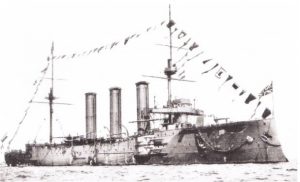 Samuel Trout one of the two final owners of the Lord Napier was a Master Mariner and probably skippered the Lord Napier in her later years. He was born in 1842 and died in 1927, his son and co –shareholder Rupert Henry Trout was born in 1875, and he lived all his life in Monmouth Street, Topsham, and by strange coincidence, was killed in action, when HMS Monmouth was sunk with all hands at the 6 beginning of the First World War The battle one the first great naval actions of that war was fought off the coast of Chile, South America.
Samuel Trout one of the two final owners of the Lord Napier was a Master Mariner and probably skippered the Lord Napier in her later years. He was born in 1842 and died in 1927, his son and co –shareholder Rupert Henry Trout was born in 1875, and he lived all his life in Monmouth Street, Topsham, and by strange coincidence, was killed in action, when HMS Monmouth was sunk with all hands at the 6 beginning of the First World War The battle one the first great naval actions of that war was fought off the coast of Chile, South America. 
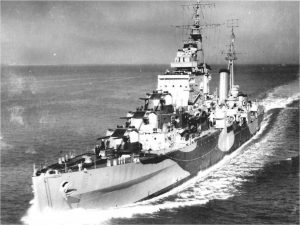 Known as the Battle of Coronel it resulted in the complete destruction of Admiral Sir Christopher Cradock’s squadron by the German Admiral Von Spee with his battleships Scharnhorst and Gneisenau, both HMS Monmouth and Good Hope were lost with all hands along with Admiral Craddock. The action prompted the then 1st Sea Lord Winston Churchill to send a fleet south which later resulted in the complete destruction of the German squadron.
Known as the Battle of Coronel it resulted in the complete destruction of Admiral Sir Christopher Cradock’s squadron by the German Admiral Von Spee with his battleships Scharnhorst and Gneisenau, both HMS Monmouth and Good Hope were lost with all hands along with Admiral Craddock. The action prompted the then 1st Sea Lord Winston Churchill to send a fleet south which later resulted in the complete destruction of the German squadron.  Samuel’s only son Wallace Henry Trout joined the Royal Navy between the wars and became a Chief Engine Room Artificer, he also lost his life in action aboard the Cruiser HMS Bonaventure when the Italian ‘Ambra’ torpedoed her off Crete in 1941 with the loss of 139 lives. One of the two survivors of the Lord Napier, Jim (Capt) Voysey lived out the rest his life fishing from Topsham also surviving another wrecking when the Ketch Julie was lost off the Lizard in 1935. Research shows Reg Chambers working in the coastal trade up to the Second World War before serving on Russian Convoy duties.
Samuel’s only son Wallace Henry Trout joined the Royal Navy between the wars and became a Chief Engine Room Artificer, he also lost his life in action aboard the Cruiser HMS Bonaventure when the Italian ‘Ambra’ torpedoed her off Crete in 1941 with the loss of 139 lives. One of the two survivors of the Lord Napier, Jim (Capt) Voysey lived out the rest his life fishing from Topsham also surviving another wrecking when the Ketch Julie was lost off the Lizard in 1935. Research shows Reg Chambers working in the coastal trade up to the Second World War before serving on Russian Convoy duties. Painting of the ketch below is by ‘Eric Voysey’ of Topsham
Painting of the ketch below is by ‘Eric Voysey’ of Topsham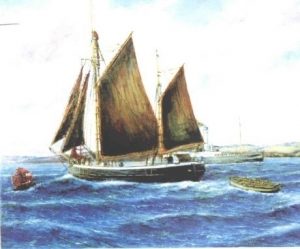 Eric Voysey the grand nephew of Jim (Capt) Voysey has worked all his life as a fisherman, he is also a talented artist who has recently (2009) had an exhibition of his art in Topsham Museum, he has painted many pictures depicting sailing ketches of the Lord Napier period including the ill-fated Julie. Now 80 he still lives in Topsham.
Eric Voysey the grand nephew of Jim (Capt) Voysey has worked all his life as a fisherman, he is also a talented artist who has recently (2009) had an exhibition of his art in Topsham Museum, he has painted many pictures depicting sailing ketches of the Lord Napier period including the ill-fated Julie. Now 80 he still lives in Topsham.
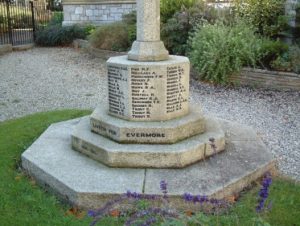 Etched on the war memorial outside Topsham’s church are the names of Rupert 7 and his son Henry both killed in action whilst serving their country in separate world wars. A link to the little fishing smack that started her life in 1868 helping to create a great fishing industry on the east coast of Britain and ending her life 43 years later as a tired old Ketch carrying bricks. Little did Jim Voysey and Reg Chambers know but in trying to save the Lord Napier that day in April 1911 just one of those bricks would reopen their stories and a social history of their a century later.
Etched on the war memorial outside Topsham’s church are the names of Rupert 7 and his son Henry both killed in action whilst serving their country in separate world wars. A link to the little fishing smack that started her life in 1868 helping to create a great fishing industry on the east coast of Britain and ending her life 43 years later as a tired old Ketch carrying bricks. Little did Jim Voysey and Reg Chambers know but in trying to save the Lord Napier that day in April 1911 just one of those bricks would reopen their stories and a social history of their a century later. 
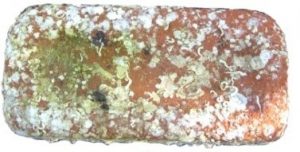 Photo of a brick from the Lord Napier
Photo of a brick from the Lord Napier